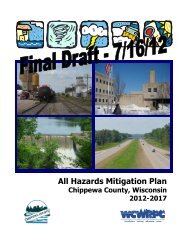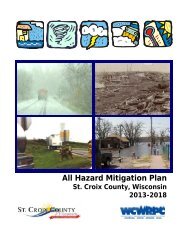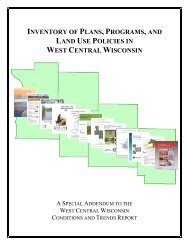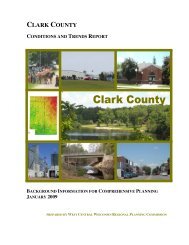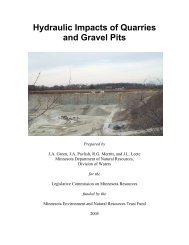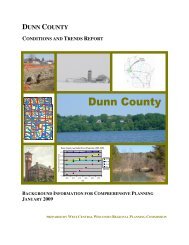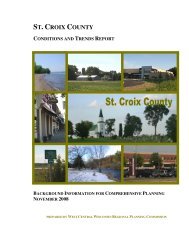The Economic Impacts of Alaska's Mining Industry - Alaska Miners ...
The Economic Impacts of Alaska's Mining Industry - Alaska Miners ...
The Economic Impacts of Alaska's Mining Industry - Alaska Miners ...
You also want an ePaper? Increase the reach of your titles
YUMPU automatically turns print PDFs into web optimized ePapers that Google loves.
CHAPTER I:<br />
PROFILE OF THE MINING INDUSTRY<br />
<strong>The</strong> mining industry, and the minerals and metals<br />
it produces, are an essential component <strong>of</strong> the<br />
average American’s way <strong>of</strong> life. According to the<br />
Mineral Information Institute, nearly seven billion<br />
tons <strong>of</strong> minerals and energy fuels had to be<br />
produced in 2004 to supply the needs <strong>of</strong> the U.S.,<br />
averaging 46,414 pounds <strong>of</strong> minerals per year for<br />
each American. 1 For instance, based on statistics<br />
from the U.S. Geological Survey, for every<br />
American:<br />
• 12,095 pounds <strong>of</strong> stone was used to make<br />
roads, buildings, bridges, and other<br />
construction uses;<br />
• 9,134 pounds <strong>of</strong> sand and gravel was used to<br />
make concrete, asphalt, roads, blocks, and<br />
bricks;<br />
• 20 pounds <strong>of</strong> copper was used in buildings,<br />
electrical and electronic parts, plumbing, and<br />
transportation;<br />
• 11 pounds <strong>of</strong> lead was used for transportation,<br />
batteries, electrical, communications, and TV<br />
screens;<br />
• 11 pounds <strong>of</strong> zinc were used to make metals<br />
rust resistant; paint, rubber, skin creams,<br />
health care, and nutrition; and,<br />
• 7,423 pounds <strong>of</strong> coal were used to produce<br />
energy. 2<br />
<strong>The</strong> mining industry is a multi-faceted and diverse<br />
part <strong>of</strong> <strong>Alaska</strong>’s economy. More than just<br />
extracting mineral resources from the earth, it<br />
involves reconnaissance exploration, prospect<br />
assessment, advanced exploration, predevelopment,<br />
mine construction, production, final<br />
reclamation and monitoring. This chapter<br />
describes the various phases <strong>of</strong> the mining “cycle”<br />
<strong>of</strong> activity.<br />
<strong>The</strong> beginning <strong>of</strong> the mining cycle is exploration,<br />
or more specifically, reconnaissance exploration –<br />
typically a regional program aimed at discovering<br />
previously unrecognized mineral deposits with<br />
economic potential.<br />
With discovery comes a more specific exploration<br />
effort, sometimes termed target exploration or<br />
advanced exploration. This is a process <strong>of</strong><br />
prospect assessment, where the deposit is<br />
1<br />
Mineral Information Institute, “Every American Born Will<br />
Need…”, March 2005.<br />
2<br />
Ibid.<br />
sampled to determine grade and tonnage and the<br />
feasibility <strong>of</strong> pr<strong>of</strong>itable mining. It is this stage <strong>of</strong><br />
mineral development that is the most complex and<br />
most dynamic. Literally dozens <strong>of</strong> constantly<br />
changing economic, financial and technical forces<br />
influence mine feasibility. Low grades, small<br />
tonnages, or high costs may mean that a deposit<br />
never advances beyond the assessment stage, or<br />
it may sit idle for decades until rising metal prices<br />
or technological advances help turn the project<br />
into a pr<strong>of</strong>itable venture.<br />
Many mineral prospects are drilled and sampled,<br />
but only one in a thousand ever becomes a mine.<br />
For those few prospects where detailed sampling<br />
indicates pr<strong>of</strong>it potential, the next step is mine<br />
development (construction). Here the ore body is<br />
prepared for mining, an ore processing mill is<br />
constructed and the support infrastructure<br />
developed. In large-scale mine development<br />
efforts, hundreds <strong>of</strong> millions <strong>of</strong> dollars are invested<br />
and hundreds <strong>of</strong> workers employed over a period<br />
<strong>of</strong> several years as the mine is readied for<br />
production.<br />
Because mineral deposits are finite resources,<br />
mining companies are constantly active at all the<br />
different stages <strong>of</strong> the mineral cycle; performing<br />
reconnaissance exploration in one area, drilling<br />
and sampling a prospect in another area, maybe<br />
developing a new mine in yet another. When one<br />
deposit is depleted and the mine must close, the<br />
mining company must be prepared to begin<br />
production at another deposit in order to survive.<br />
This is the mineral cycle.<br />
<strong>The</strong> following discussion is a more detailed<br />
description <strong>of</strong> mineral exploration, mine<br />
development and production.<br />
Reconnaissance Exploration and<br />
Advanced Exploration<br />
<strong>The</strong> business <strong>of</strong> mineral exploration has become<br />
increasingly sophisticated in recent years.<br />
Reconnaissance exploration programs <strong>of</strong>ten begin<br />
with analysis <strong>of</strong> satellite or high altitude aerial<br />
photographs covering hundreds <strong>of</strong> square miles.<br />
Depending on the target minerals, airborne<br />
geophysical surveys may also be employed over<br />
large tracts <strong>of</strong> land. Geochemistry plays an<br />
important role in mineral exploration today.<br />
Chemical analysis <strong>of</strong> stream sediment and soil<br />
samples allows mining companies to preliminarily<br />
test mineral potential without actually sampling the<br />
underlying bedrock.<br />
<strong>The</strong> <strong>Economic</strong> <strong>Impacts</strong> <strong>of</strong> <strong>Alaska</strong>’s <strong>Mining</strong> <strong>Industry</strong> McDowell Group, Inc. • Page 6



